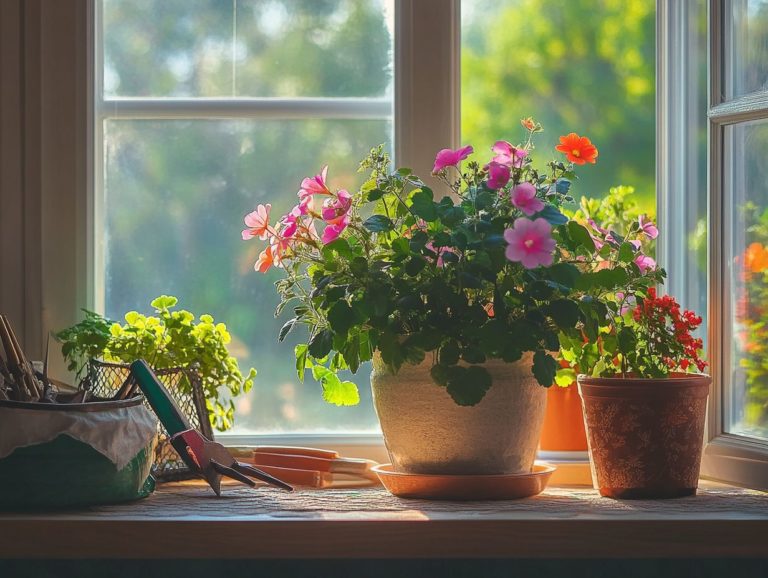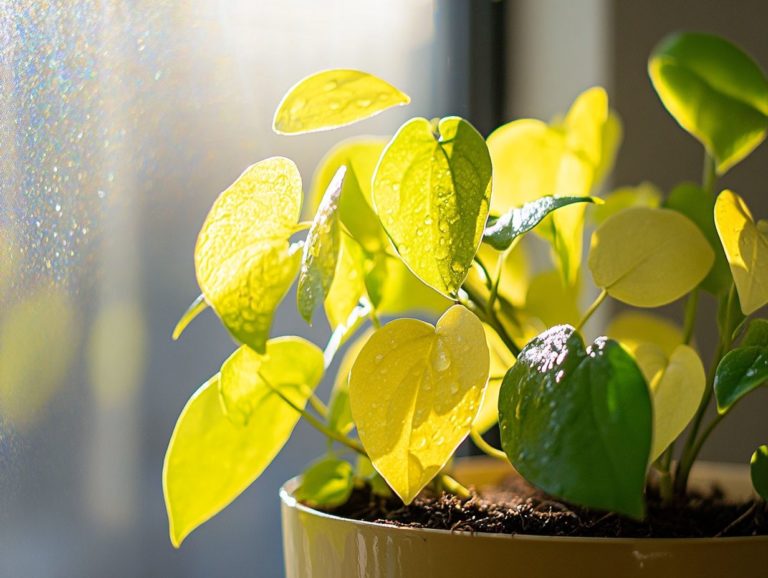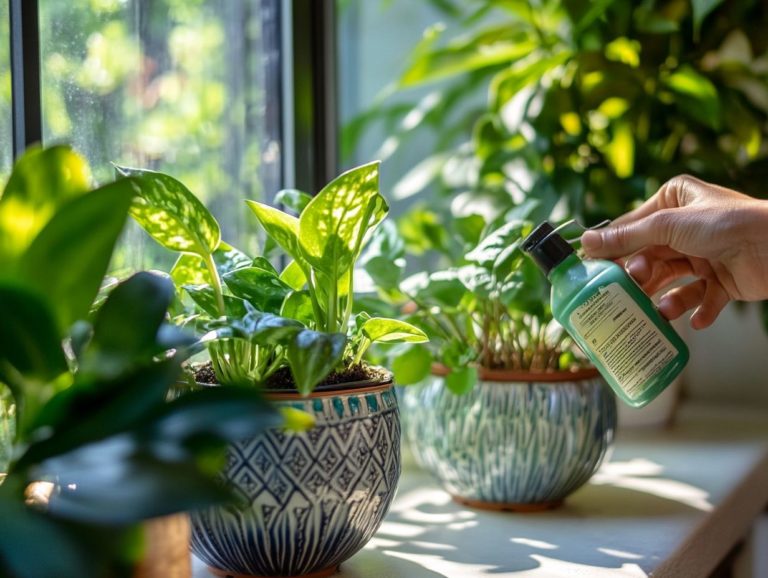What are the Common Indoor Plant Fungi?
Indoor plants have the remarkable ability to transform your home into a lush sanctuary, but they often contend with stubborn fungi that threaten their vitality.
Grasping the nature of fungi and their impact on your plants is essential for any dedicated plant lover. You ll explore common types of indoor plant fungi, learn how to identify and treat them, and discover effective strategies for prevention.
Become adept at spotting the signs of fungal infestations. Master the art of caring for your plants during treatment.
Prepare to ensure your indoor garden not only survives but thrives beautifully!
Contents
Key Takeaways:

- Fungi can negatively affect indoor plants, causing infections and diseases.
- Common types of indoor plant fungi include powdery mildew, root rots, and leaf spots.
- Preventing fungal infestations in indoor plants is possible through proper care and maintenance, such as providing adequate sunlight and ventilation.
Understanding Indoor Plant Fungi
Understanding indoor plant fungi is crucial for anyone dedicated to nurturing a thriving indoor garden. Fungi can lead to a range of plant diseases, impacting everything from the roots to the leaves.
You ll want to watch out for common issues like powdery mildew, root rot, and various fungal infections. These can manifest as unsightly leaf spots and ultimately jeopardize your plants’ health.
Ensure effective air circulation and maintain the right amount of moisture in the air to significantly reduce these risks. Being informed about the types of fungi that can affect your indoor plants enables you to take proactive measures.
This knowledge ensures that your greenery remains vibrant and healthy.
What is Fungi and How Does it Affect Plants?
Fungi represent a fascinating and diverse group of organisms that play crucial roles in various ecosystems. They can influence the health of your houseplants both positively and negatively.
In indoor gardening, certain fungi can be the culprits behind severe plant diseases, such as root rot and bacterial infections. This ultimately jeopardizes your plant’s well-being.
These organisms flourish in damp and warm conditions that often arise in poorly ventilated areas. While their ability to decompose organic matter is essential for nutrient cycling in nature, this same capability can present challenges for your indoor plants.
If you overwater or experience high humidity, you might create a perfect breeding ground for fungal spores. This leads to problems like powdery mildew or downy mildew.
By grasping these dual aspects of fungi, you can navigate your indoor gardening environment with greater finesse. Keep your plants thriving while minimizing the risks posed by these often underestimated life forms.
Common Types of Indoor Plant Fungi
Several common types of indoor plant fungi can threaten your cherished greenery, including powdery mildew, anthracnose, and sooty mold.
These fungi may present themselves in various ways think leaf spots, stunted growth, and a general decline in your plant’s vitality. Recognizing these fungal infections early on is essential for effective treatment and prevention.
Safeguard the health of your indoor oasis today!
Identifying and Treating Common Fungal Infections

Identifying and addressing common fungal infections in your indoor plants is vital for preserving their health and vitality. These infections can manifest as leaf spots, powdery mildew, and other visible symptoms that demand prompt attention to prevent further damage.
By closely examining the leaves and stems for any signs of discoloration, wilting, or fuzziness, you can catch fungal issues early before they escalate. It’s also essential to assess soil moisture levels, as overly damp conditions can create an ideal breeding ground for these pathogens.
Water your plants wisely to keep them happy and healthy! Practicing proper watering techniques and soil drainage will help you mitigate the risks.
In terms of treatment, you have a variety of options at your disposal. From commercial houseplant fungicides that target specific strains to natural remedies like neem oil, which can be effective without the use of harsh chemicals, there are ways to address these issues.
You can also use organic fungicides such as potassium bicarbonate. By employing both preventive and reactive measures, you can ensure a thriving indoor garden, free from the grips of fungal troubles.
Preventing Indoor Plant Fungi
Preventing fungi in your indoor plants demands a thoughtful and comprehensive approach that tackles multiple environmental factors, including humidity control and air circulation. By implementing effective strategies for plant disease prevention, you can significantly diminish the risk of fungal infections that pose a threat to your indoor garden.
Effective Strategies for Fungal Prevention
Effective strategies for preventing fungal issues in your indoor plants include:
- Maintaining optimal humidity levels
- Ensuring adequate air circulation
- Implementing proper drainage techniques
These essential practices play a vital role in safeguarding your plants from fungal infections.
By monitoring humidity closely, you can cultivate a balanced environment that actively discourages the growth of mold and mildew. A hygrometer is a tool to measure humidity levels, while placing your plants in well-ventilated areas ensures good air circulation.
Adjusting your watering habits to allow the soil to dry out between sessions will significantly reduce excess moisture, a common breeding ground for pathogens. Additionally, using sterile pots and regularly inspecting your plants can further strengthen your defenses.
You can easily create a thriving indoor garden with just a few simple changes!
Signs of Fungal Infestation in Indoor Plants
Act fast and keep an eye out for common symptoms such as:
- Leaf yellowing
- Unexpected leaf drop
- Visible fungal growth on affected leaves
These indicators can often signal underlying plant diseases that need your attention.
Recognizing Symptoms and Taking Action

Recognizing the symptoms of fungal infections is essential for you to take timely action and safeguard your indoor plants. Look out for signs such as leaf spots, wilting foliage, and unusual growth patterns they’re all clues that a fungal infection might be lurking.
When these symptoms surface, it’s crucial to examine each plant closely to assess the infection’s severity. Take note of any discoloration on the leaves and check for mold or fuzz developing on the soil’s surface, which can exacerbate fungal leaf spots. Additionally, being aware of the most common indoor plant pests can help you identify and address potential issues early.
Once you’ve identified the issue, the first step in treatment is to gently clean the infected leaves with a damp cloth to remove any visible spores. After that, apply the right fungicide treatment, tailored to combat the specific type of fungus plaguing your plant.
Regular monitoring and ensuring proper air circulation will help prevent future outbreaks, keeping your indoor greenery healthy and vibrant.
How to Care for Plants with Fungal Infections
Caring for plants impacted by fungal infections demands your utmost attention to detail and using effective treatment methods. Adopting proper care practices for plants, such as vigilantly monitoring soil moisture and ensuring adequate drainage, is crucial for the recovery of infected plants.
Your dedication to these practices truly transforms your plants health!
Proper Maintenance and Treatment Techniques
Effective maintenance and treatment techniques are essential for restoring the health of plants affected by fungal infections. Consider strategies like applying natural fungicides and adjusting your care routines to boost overall plant vitality.
Inspect your plants regularly for early signs of fungal growth. Act quickly! Regular inspections can save your plants from severe damage.
Implementing a trimming routine and ensuring proper airflow can significantly lower humidity levels, which fungi thrive on. Opt for organic fungicides, like those derived from neem oil or potassium bicarbonate, as a gentle yet effective alternative to harsh chemicals.
Adjust your watering practices by allowing the soil to dry between intervals, based on the specific plant type. This creates an environment that s less inviting for fungi.
By prioritizing these vital practices, you can substantially enhance the resilience and vibrancy of your indoor or outdoor garden.
Frequently Asked Questions
What are the Common Indoor Plant Fungi?

Common indoor plant fungi are types of fungi frequently found in indoor environments that can affect the health of indoor plants.
What are the signs of indoor plant fungal infection?
Signs of indoor plant fungal infections include:
- Wilting
- Yellowing or browning of leaves
- Stunted growth
- Presence of fuzzy or powdery growth on the plant
What are some common types of indoor plant fungi?
Common types of indoor plant fungi include:
- Powdery mildew
- Leaf spots
- Black spot
- Root rot
How can I prevent indoor plant fungal infections?
To prevent indoor plant fungal infections and ensure plant health:
- Provide adequate air circulation
- Avoid overwatering
- Regularly clean infected leaves
- Inspect your plants for signs of fungal growth
Can indoor plant fungi be harmful to humans?
While most indoor plant fungi are not harmful to humans, some can cause allergies or respiratory problems for people with sensitive immune systems, especially in adverse conditions.
How can I treat indoor plant fungal infections?
Treatment for indoor plant fungal infections may include:
- Removing dead plant parts
- Using houseplant fungicide or natural fungicides
- Improving cultural practices, such as proper watering and ventilation
Consider reviewing technical terms like fungicide or air circulation for further understanding.






